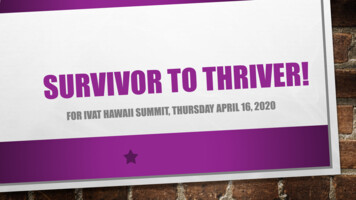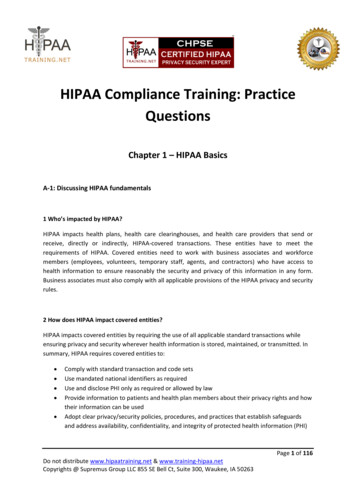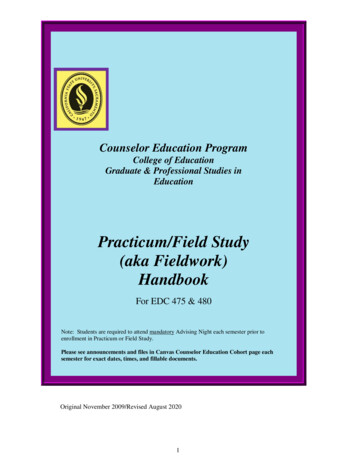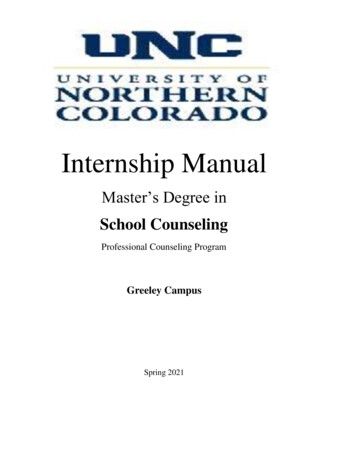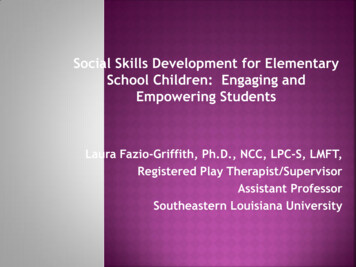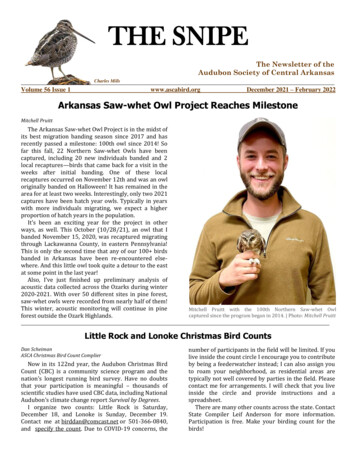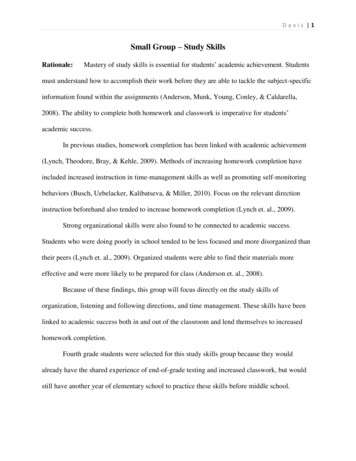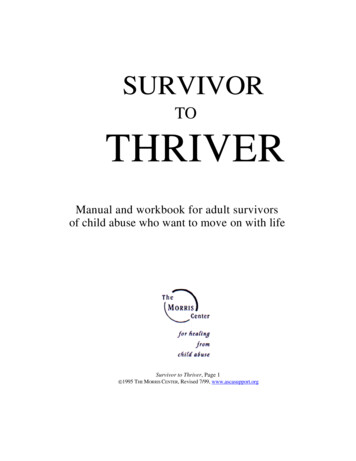
Transcription
SURVIVORTOTHRIVERManual and workbook for adult survivorsof child abuse who want to move on with lifeSurvivor to Thriver, Page 1 1995 THE MORRIS CENTER, Revised 7/99, www.ascasupport.org
THE MORRIS CENTERfor healing from child abusePO Box 281535San Francisco . CA . 94128phone:e-mail:website:415 .937 1854info@ascasupport.orgwww.ascasupport.org 1995THE NORMA J. MORRIS CENTERfor healing from child abuseAll rights reserved, including the right of reproductionIn whole or in part in any form.Revised10/95, 7/96, 7/99, 11/06, 5/15The information and program contained herein arenot intended to be psychotherapy or to substitutefor consultation with a licensed health or mentalhealth professional. Application of thecontents is at the reader's sole discretion.Survivor to Thriver, Page 2 1995 THE MORRIS CENTER, Revised 7/99, www.ascasupport.org
TABLE OF CONTENTSAbout THE MORRIS CENTER. . . . . . . . . . . . . . . . . . . . . . . . . . . . . . . 5Chapter One: The ASCA Step Work ProgramIntroduction.7Step Work, ASCA-Style . . . . . . . . . . . . . . . . . . . . . . . . . . . . . . . 8Responsible Recovery, Responsible Therapy . . . . . . . . . . . . . . . 11Chapter Two: Safety First!Introduction . . . . . . . . . . . . . . . . . . . . . . . . . . . . . . . . . . . . . . . . . 17Safety Checklist . . . . . . . . . . . . . . . . . . . . . . . . . . . . . . . . . . 19Suicide/Harmful Behavior Checklist . . . . . . . . . . . . . . . 20Creating Your Plan For Safety First! . . . . . . . . . . . . . . . . . . . . . 21Awareness Assessment Action . . . . . . . . . . . . . . . . . . . . . 21Building Your Support System . . . . . . . . . . . . . . . . . . . . . 24Identifying Your Support Network. . . . . . . . . 24ASCA Colleagues . . . . . . . . . . . . . . . . . . . . . . . . . . 25Resolving Abusive Relationships First . . . . . . . . . . . . . . . 25Personal Relationships Checklist . . . . . . . . . . . . . . . 26Stabilizing Your Life . . . . . . . . . . . . . . . . . . . . . . . . . . 27Crisis "Hot Spots" Checklist . . . . . . . . . . . . . . . 28Self-Soothing Activities . . . . . . . . . . . . . . . . . . . . . . . . . . 31Living Safety First! A Final Note . . . . . . . . . . . . . . . . . . . . . 33Chapter Three: Assessing Child AbuseIntroduction . . . . . . . . . . . . . . . . . . . . . . . . . . . . . . . . . . . . . . . . . . . 35What Is Child Abuse? . . . . . . . . . . . . . . . . . . . . . . . . . . . . . . . . 36Physical Abuse . . . . . . . . . . . . . . . . . . . . . . . . . . . . . . . . 36Sexual Abuse. . . . . . . . . . . . . . . . . . . . . . . . . . . . . . . . . . . . . 39Emotional Abuse. . . . . . . . . . . . . . . . . . . . . . . . . . . . . . . 42What Are The Adult Repercussions of Child Abuse? . . . . . . . . . . 47Relationship Problems . . . . . . . . . . . . . . . . . . . . . . . . . . 48Low Self-Esteem . . . . . . . . . . . . . . . . . . . . . . . . . . . . . . . . 49Self-Sabotage. . . . . . . . . . . . . . . . . . . . . . . . . . . . . . 51Sexual Problems . . . . . . . . . . . . . . . . . . . . . . . . . . . . . . . . 53Symptoms of Trauma . . . . . . . . . . . . . . . . . . . . . . . . . . 55Physical Ailments . . . . . . . . . . . . . . . . . . . . . . . . . . . . . . . . 57Social Alienation . . . . . . . . . . . . . . . . . . . . . . . . . . . . . . . . 59Handling Feelings.Conclusion . . . . . . . . . . . . . . . . . . . . . . . . . . . . . . . . . . . . . . . . . . . 63Survivor to Thriver, Page 3 1995 THE MORRIS CENTER, Revised 7/99, www.ascasupport.org
TABLE OF CONTENTSChapter Four: Stage One — RememberingStage One: Remembering . . . . . . . . . . . . . . . . . . . . . . . . . . . . . . . . 65Step One. . . . . . . . . . . . . . . . . . . . . . . . . . . . . . . . . . . . . . . . . . 66Step Two. . . . . . . . . . . . . . . . . . . . . . . . . . . . . . . . . . . . . . . . . . 69Step Three. . . . . . . . . . . . . . . . . . . . . . . . . . . . . . . . . . . . . . . . . . 72Step Four. . . . . . . . . . . . . . . . . . . . . . . . . . . . . . . . . . . . . . . . . . 75Step Five . . . . . . . . . . . . . . . . . . . . . . . . . . . . . . . . . . . . . . . . . . 77Step Six. . . . . . . . . . . . . . . . . . . . . . . . . . . . . . . . . . . . . . . . . . 79Step Seven . . . . . . . . . . . . . . . . . . . . . . . . . . . . . . . . . . . . . . . . . . 82Chapter Five: Stage Two — MourningStage Two: Mourning. . . . . . . . . . . . . . . . . . . . . . . . . . . . . . . . 85Step Eight . . . . . . . . . . . . . . . . . . . . . . . . . . . . . . . . . . . . . . . . . . 86Step Nine. . . . . . . . . . . . . . . . . . . . . . . . . . . . . . . . . . . . . . . . . . .88Step Ten. . . . . . . . . . . . . . . . . . . . . . . . . . . . . . . . . . . . . . . . . . .90Step Eleven. . . . . . . . . . . . . . . . . . . . . . . . . . . . . . . . . . . . . . . . . . . 92Step Twelve . . . . . . . . . . . . . . . . . . . . . . . . . . . . . . . . . . . . . . . . . . .94Step Thirteen. . . . . . . . . . . . . . . . . . . . . . . . . . . . . . . . . . . . . . . . . 97Step Fourteen. . . . . . . . . . . . . . . . . . . . . . . . . . . . . . . . . . . . . 99Chapter Six: Stage Three — HealingStageThree:Healing.101StepFifteen. 102StepSixteen. 103Step Seventeen. . . . . . . . . . . . . . . . . . . . . . . . . . . . . . . . . . . . . 105Step Eighteen. . . . . . . . . . . . . . . . . . . . . . . . . . . . . . . . . . . . . 107Step Nineteen. . . . . . . . . . . . . . . . . . . . . . . . . . . . . . . . . . . . . 110Step Twenty . . . . . . . . . . . . . . . . . . . . . . . . . . . . . . . . . . . . . . . . . .111Step Twenty-One. . . . . . . . . . . . . . . . . . . . . . . . . . . . . . . . . . . . . 114ASCA Stages &Steps . . . . . . . . . . . . . . . . . . . . . . . . . . . . . . . . . . . . . . . . . 115Survivor to Thriver, Page 4 1995 THE MORRIS CENTER, Revised 7/99, www.ascasupport.org
ABOUT THE MORRIS CENTERA non-profit 501(c)(3) public benefit corporation, THE MORRIS CENTER wasfounded in 1991 (as the Adult Survivors of Incest Foundation) to provide individualand group sliding scale psychotherapy and low-cost educational and self-helpprograms for adult survivors of sexual abuse. In November 1993 the name of theorganization was changed to The Norma J. Morris Center for healing from childabuse. This changed reflected the fact that its programs had expanded to servesurvivors of physical and emotional, as well as sexual, abuse, and to honor theorganization's co-founder and principal benefactor, Norma Morris.In 1994, perceiving an increased need for cost-effective, easily replicableprograms, THE MORRIS CENTER shifted its primary focus to our ASCA supportprogram and discontinued its psychotherapy program. ASCA began to take shapein January, 1993, when George J. Bilotta, Ph.D., THE MORRIS CENTER's ExecutiveDirector, asked J. Patrick Gannon, Ph.D., to develop his ideas for a "secondgeneration" self-help group for adult survivors of child abuse. This edition of theSurvivor to Thriver manual is an updated and expanded edition of Dr. Gannon'sbook: Soul Survivors: A New Beginning for Adults Abused as Children along withadditional material from our unpublished manual The ASCA Workbook.In February, 1993, the ASCA Leadership Council, composed of volunteersinterested in developing the new program, started to create the Stage One meetingformat, program guidelines and Co-Facilitator responsibilities. The first ASCAmeeting was held in May 1993, in San Francisco. ASCA has continued to evolveand has become a powerful and effective support program for adult survivors ofchild abuse.In September 1999, THE MORRIS CENTER began to promote the ASCAprogram nationally through the World Wide Web. It is our desire and hope thatthrough this efficient and cost effective avenue, ASCA will become available tosurvivors of child abuse throughout the country and world.Survivor to Thriver, Page 5 1995 THE MORRIS CENTER, Revised 7/99, www.ascasupport.org
Survivor to Thriver, Page 6 1995 THE MORRIS CENTER, Revised 7/99, www.ascasupport.org
Chapter OneASCA Step Work ProgramINTRODUCTIONWelcome to our Survivor to Thriver manual! The Norma J. Morris Centerfor Healing from Child Abuse (or THE MORRIS CENTER), in collaboration with J.Patrick Gannon, Ph.D., THE MORRIS CENTER's former Clinical Consultant, hascreated this manual as part of its program of services for adult survivors ofphysical, sexual and emotional child abuse. Virtually since ASCA began in 1993,participants have asked for a workbook or manual to be used as part of theirrecovery process. In his 1989 book SOUL SURVIVORS: A New Beginning forAdults Abused as Children, Dr. Gannon outlined a three-stage alternative recoverymodel that was the blueprint for ASCA, but that book is no longer in print.Consequently, THE MORRIS CENTER has taken portions of Dr. Gannon's earlierwritings, revised and updated them to reflect the ASCA program as it operatestoday and added significant explanatory material. The result is before you.This manual is designed to complement your ASCA meeting participation.Use it individually, but as a supplement to regular ASCA meeting attendance. Ofcourse, you are welcome to bring your manual to meetings with you, but you willnot find any exercises or sections that are specifically keyed to meetingparticipation. You will first find a chapter entitled Safety First!, designed to helpyou evaluate your present level of safety and stability and establish a firm footingon which to begin your recovery journey. This is followed by a lengthy chapter onthe types of child abuse and some of the ways the consequences of child abuse canaffect your adult life. Chapters Three, Four and Five correspond to Stages One,Two and Three of the ASCA program, respectively. Each chapter contains a sectionon each of the seven steps that make up that particular stage. Each section includesa discussion of the step and its role in recovery and some exercises, survival tipsand resource material to help you work through the issues. It is ourSurvivor to Thriver, Page 7 1995 THE MORRIS CENTER, Revised 7/99, www.ascasupport.org
hope that you will use the questions, exercises and suggestions included with eachof the steps as a framework for your ASCA participation. Using the contents of themanual in this way will bring an immediacy and concreteness to your ASCAshares, one that will help both you and your fellow survivors to achieve someclarity about the particular step and what role it plays in your recovery.There are good reasons for encouraging you to use this manual inconjunction with attending meetings or participating in our online meeting atwww.ascasupport.org. One of the benefits of attending ASCA meetings isexperiencing the sense of community that develops between survivors who arediscovering that they are not alone in their abuse experiences and recovery efforts.The carefully structured ASCA meeting formats make it easier to shareexperiences and to start to trust others both key parts of breaking out of theisolation that characterizes most survivors' lives. The skills that you practice andobserve in ASCA meetings often, if not always, will prove valuable in yourinteractions in the larger world. While there is much to be gained from using themanual individually, your recovery will be more balanced and, we believe, morerewarding if you also take advantage of the group experience afforded by ASCAmeetings. For these reasons we encourage you to use this manual as an adjunct toattending ASCA meetings and individual or group psychotherapy (if you havethese).ASCA is a support program with an individual and group component. It isnot professional psychotherapy, nor is it intended to take the place of individual orgroup therapy. Unlike some other self-help programs, though, ASCA does not holdan anti-therapy or anti-professional stance. In fact, THE MORRIS CENTER believesthat ASCA works most effectively in conjunction with individual or group therapy,and we encourage survivors to combine professional consultation and ASCA if at allpossible. The last section of this chapter talks a little more about the role of therapy,finding a good therapist and the recovery process in general.ASCA-STYLEWhat is ASCA?As you probably know if you are attending ASCA meetings, ASCA is asupport program with several unique features. First, it is psychologically-based andwas created expressly to address the particular needs of adult survivors of childabuse. To our knowledge, it is the only program that provides aSurvivor to Thriver, Page 8 1995 THE MORRIS CENTER, Revised 7/99, www.ascasupport.org
psychological framework for the complex process of healing from child abuse andmoving on with life. ASCA combines elements drawn from the recoverymovement (programs such as Alcoholics Anonymous) with a theoretical approachthat emphasizes recognizing and resolving past pain, identifying maladaptivecoping behaviors and developing new skills that foster self-esteem and healthyrelationships.Second, ASCA meetings, which follow carefully scripted meeting formats,are run by lay facilitators, themselves survivors, who have received training to helpthem handle the problems that may arise in meetings and to provide a safe,structured environment for fellow survivors. Third, ASCA meetings are open tosurvivors of all types of child abuse: physical, sexual and emotional. And fourth,ASCA is the fruit of a collaborative effort between THE MORRIS CENTER,survivors, volunteers, professionals, community agencies and the community atlarge. As such, it benefits from a broad range of experience and skills.The purpose of ASCA meetings is to allow survivors to share their abuseand recovery experiences; to receive support and affirmation for their recoveryefforts; to try out new, more adaptive behaviors and, in so doing, to betterunderstand themselves and their recovery process. As survivors come to termswith their abuse histories and develop healthier behaviors and relationshippatterns, they are able to test out some of those new patterns. The increasedconfidence, mastery and sense of responsibility that survivors build as a result ofparticipating in ASCA meetings are skills that transfer to the larger world.ASCA and 12-Step ProgramsAs mentioned above, ASCA is a recovery program based on psychologicalconcepts of recovery. While many ideas represented in 12-Step programs may bevaluable for survivors of child abuse, some are not. In particular, many survivorshave difficulty with the idea of "surrendering to a higher power." The challenge formany survivors is to find the power to change within oneself, not in an outsidesource. This is related to the fact that, for most survivors, the source of power andcontrol was always located outside of themselves, in their parent or other abuser.To find the power to change from within is to break old, persistent patterns.Some survivors also have problems with some 12-Step programs' recurringthemes of forgiveness, blame and misplaced responsibility. 12-Step programs startwith the belief that the individual has committed wrongs, is responsible for thosewrongs and must make amends to others for those wrongs. These beliefs are notparticularly applicable to survivors of child abuse. Adult survivors were abused asSurvivor to Thriver, Page 9 1995 THE MORRIS CENTER, Revised 7/99, www.ascasupport.org
children. As children, they had no control or choice over the abuse, and it was nottheir fault that the abuse occurred. The abuse was the doing of another person (orpersons), and many adult survivors do not feel that they should make amends forbehavior that was not their responsibility and over which they had no control. It isfor these reasons, among others, that THE MORRIS CENTER believes that ASCA'spsychological approach is more suitable for recovery from child abuse.However, this does not mean that ASCA is opposed to 12-Step programs.One of ASCA's principles is a policy of "addition, not competition," with respectto 12-Step programs, and we do not compete with 12-Step programs for yourparticipation. We believe that 12-Step groups are extremely useful andappropriate for persons facing addictions and attempting to live clean and soberlives. ASCA is deeply grateful to Alcoholics Anonymous and other 12-Stepprograms as the godparents of the recovery movement. Without them, therewould be no ASCA — but we view ourselves as a separate program for aseparate problem.How Does ASCA Step Work Work?Step Work is a process whereby you concentrate on one particular step at atime in a given recovery program. It is really an organizing tool to focus your workon one issue at a time so that you do not become overwhelmed by the number andenormity of the tasks that comprise a recovery journey. The idea is to explore in afocused manner the issues presented by a particular step, without confusing theseissues with other issues related to other steps.ASCA's 21 Steps are a statement of the tasks and issues that most adultsurvivors face during their recovery from child abuse. Think of them as signpostsor landmarks along the road of recovery. Unlike some self-help programs, ASCAdoes not require that participants work the steps — although you may choose to doso — or that the steps be worked in a linear order. Survivors often spiral throughseveral steps simultaneously and may return to earlier steps after they have reachedclosure on later ones, or as new material surfaces in their recovery process. Yourconcept of Step Work may be to emphasize a particular step in your shares inASCA meetings, or in your individual or group therapy sessions.The steps of Stage One are concerned with the memories of your childhoodabuse. You must acknowledge what happened in the past before you can moveforward in recovery. This becomes the foundation upon which you build yourrecovery. Stage Two focuses on examining your adult behavior, connecting yourpresent strengths and weaknesses to the abuse you suffered and the copingSurvivor to Thriver, Page 10 1995 THE MORRIS CENTER, Revised 7/99, www.ascasupport.org
mechanisms you adopted, and allowing the child within you to grieve the aspectsof childhood that never existed for you. Stage Three involves consolidating yournew, healthier feelings and behaviors, your feelings about the abuse and your adultgoals into a new sense of self and then going out and "practicing" this new self inthe world.Remember that not all of the 21 Steps are going to have equal relevance toyour life and your abuse history. Depending on your personal experience, somesteps will have a more profound significance for you, and these are the steps whereyou might want to concentrate your focus. You might work on one issue at aparticular time because it is the issue that is most relevant to your life at this time.You might work on several steps simultaneously, and you might even feel thatsome steps have no relevance to your particular experience. You are the ultimatejudge of which steps to work and when to work them.RESPONSIBLE RECOVERY,RESPONSIBLE THERAPYFalse Memories, Real MemoriesChild abuse, recovered and repressed memories and "false memorysyndrome" are very sensitive topics and are currently highly controversial subjectsin our society. Research into the process of memory encoding, storage and retrievalis still in its infancy, but there is substantial evidence that indicates that memoriesare not stored intact. Instead, different elements of what is considered "a memory"may be stored in different parts of the brain and then "reassembled." Thisfragmentation of memory storage may be even more pronounced if the event(s) wastraumatic and occurred very early in life. One of the reasons posited for this is thatthe portion of the brain responsible for coalescing memory fragments into a singlewhole does not develop until sometime between the ages of 2 and 4 years. This,together with the passage of time, means that there can be distortion andfragmentation of the details of a given memory.However, abuse survivors usually remember at the very least that theirabuse occurred, even if they do not remember exact details of their abuse orconfuse the details with other material. In fact, most studies estimate that at leastSurvivor to Thriver, Page 11 1995 THE MORRIS CENTER, Revised 7/99, www.ascasupport.org
50% of persons enter therapy with all or part of their abuse memories intact. Theremaining group may have been so traumatized by their abuse that they haveliterally blocked the memories until such time as it is safe for them to remember.This protective process, called repression, is a standard concept in mostpsychotherapeutic disciplines, and is not unique to the area of child abuse andrecovered memories. It is the psyche's means of protecting the individual fromexcessive trauma — whatever the nature — until such time as the person is readyto address the memories.THE MORRIS CENTER believes that the vast majority of survivors who comeforth to deal with their abuse histories were in fact abused to some extent and maywell have repressed some or all of their memories of the abuse, only to have themsurface later due to some kind of external trigger or their own readiness to dealwith the issues. However, this does not mean that there are not valid cases inwhich memories have been fabricated, suggested or even "implanted" and aretherefore not legitimate. Actions of unethical therapists can cause this, but so canexaggerated media reports, sensational "talk show" banter, and individualimagination. We believe that some, if not all, of the persons who have recoveredmemories and then recanted their stories are telling the truth. We also believe thatthe number of these "false memory" cases is minuscule and statistically irrelevantwhen compared to the actual incidence of child abuse and the number of personswho enter therapy with at least some of their memories intact. Nevertheless, weencourage you to be careful with this aspect of your recovery. Only you can be thetrue judge as to whether you were abused as a child. There may be corroboratingevidence — a doctor's report, a friend or neighbor who "knew" but didn't sayanything — but in the end, you must be truthful with yourself about whathappened to you.The Role of Professional TherapyAs mentioned earlier, ASCA is not anti-therapy or anti-professionals. Infact, ASCA is designed to work in conjunction with individual or grouppsychotherapy. We believe that professional help can be of tremendous value tosurvivors attempting to overcome the negative effects of their abuse. Some peopletry to do this on their own or by attending support and self-help groups only, butrecovery usually proceeds more quickly and more safely if you are working with askilled professional. If you are debating whether to seek professional help, a keyquestion to ask yourself is, "Am I able to face the abuse on my own and resolve itto the extent that my symptoms and problems in adult living go away?" If theanswer is "No," then you may want to consider professional help.Survivor to Thriver, Page 12 1995 THE MORRIS CENTER, Revised 7/99, www.ascasupport.org
For many survivors, a professional individual or group therapy relationshipis the cornerstone of their recovery, without which other changes would be hard tocome by. In a relationship with an ethical and clinically appropriate professional,the client experiences safety, respect for boundaries, sensitivity to needs andvalidation of both the abuse that occurred and the role of recovery in creating ahappy and meaningful life.If you are unable or unwilling to enter therapy, though, do not despair!You can still use this manual and other ASCA material found on our web sitewww.ascasupport.org to help you in your recovery journey. If you are in thisposition, you will want to take special care in selecting and building your supportnetwork, as these people — friends, supportive family members, clergymembers, teachers, and others — will serve some of the functions of a therapistfor you. You will want to pay special attention to the section in Chapter Two,"Building Your Support System," for help with this task. And, of course, ASCAmeetings will probably assume a greater role in your recovery if you are unableto be in therapy.Choosing a TherapistAs in any profession, there are therapists who demonstrate greater andlesser amounts of responsibility in their practices. Neither ASCA NOR THE MORRISCENTER is in the business of evaluating individual practitioners. However, weencourage ASCA participants who are interested in individual and/or groupprofessional therapy to select their therapist(s) carefully. Do be an informedconsumer. Do ask questions about the therapist's training, experience andlicensure. If you feel comfortable doing so, ask about the therapist's theoreticalorientation and what kinds of techniques or practices s/he uses in therapy. To theextent possible, trust your senses.The current debate about child abuse, memories and recovery oftenmentions "repressed memory therapy." As a point of clarification, there is no suchidentified discipline. There are various therapeutic techniques — some morereputable than others — that therapists may use in working with clients. Therapistsmay use these same techniques with clients who have no abuse issues as withclients who either know or suspect that they may have been abused. The real keyto competent therapy lies not in techniques but in the expertise and ethical stanceof the therapist.Once you have entered into a therapeutic relationship with a professional, ifyou feel yourself being pushed too fast or encouraged too much, or you areSurvivor to Thriver, Page 13 1995 THE MORRIS CENTER, Revised 7/99, www.ascasupport.org
uncomfortable with suggested therapeutic methods, try to discuss your concernswith your therapist. If the therapist's suggestions don't feel right or aren'tcompatible with your memories, feelings or beliefs about your abuse, then try todiscuss this as well. You should be comfortable with the pace of your therapy andbe able to discuss your progress openly with your therapist. An ethical therapistwill never force you to engage in an activity or recovery technique about whichyou are truly uncomfortable. Ultimately, you are the authority on your ownexperiences. Although your therapist is a professional and may possess knowledgeand skills that you do not, you bear the responsibility of being an active participantin your recovery.This isn't to say that therapy won't, at times, be painful and difficult,especially when working on deep-seated issues around child abuse. But there is adifference between your natural resistance to looking at and dealing with painfulmemories, and the discomfort that arises when you feel that something is beingsuggested to you that is instinctively wrong or uncomfortable. If this happens, andif you and your therapist cannot come to a mutually agreeable solution, thenperhaps it's time to consider changing therapists.What About Confronting My Abusers?This is a very difficult question, and one that only you can answer foryourself. Step 18 of ASCA reads: "I have resolved the abuse with my offendersto the extent that is acceptable to me." For some survivors, this means an internalcoming to terms with the abuse and the abuser(s) but does not involve directconfrontation. For others, it means direct confrontation, either face-to-face or byletter or phone. For still others it may mean writing articles, stories, newspaperop-ed pieces or by speaking out in public gatherings. And for still others it maymean pursuing legal action to gain restitution for the abuse suffered. Everysurvivor is different in his/her need to confront the abuser(s). Neither ASCA norTHE MORRIS CENTER has a policy or position on confrontation. Instead, webelieve that each survivor must make this choice individually. We do, however,encourage survivors to think carefully about their options and the consequencesof their choices.Confrontation of any sort, and especially legal action, can be verydisruptive to life in general and the recovery process in particular. The legalsystem is inherently adversarial in nature. The objective, evidence-basedstandards of proof required for either a civil judgment or a criminal convictionare not easily met by testimony relating to memory, memory retrieval orpsychotherapeutic techniques and interpretations. Perhaps most importantly,Survivor to Thriver, Page 14 1995 THE MORRIS CENTER, Revised 7/99, www.ascasupport.org
though, suing your abuser brings all of the old feelings of hurt, shame, guilt,antagonism, anger and sadness that accompanied the abuse to the forefront of yourconscience. You are likely in effect to relive your abuse experiences in court. Forthese reasons we encourage survivors to think about, and get information on, thepossible consequences of various courses of action and to weigh whether they aresufficiently grounded in their recovery to withstand the pressures and stress thatalmost always accompany a decision to pursue legal action.Survivor to Thriver, Page 15 1995 THE MORRIS CENTER, Revised 7/99, www.ascasupport.org
Survivor to Thriver, Page 16 1995 THE MORRIS CENTER, Revised 7/99, www.ascasupport.org
Chapter TwoSafety First!INTRODUCTIONWe have included this chapter at the beginning of this manual becausefeeling safe in your recovery should ALWAYS come first. Whether you areworking on Step One or Step Twenty-one, you need a framework of physical andemotional safety in order to progress in your recovery, because child abuse — atits core — is about being and feeling unsafe. People can change only from aposition of safety. If you don't feel safe, then you won't progress in your recovery.You want a strong foundation upon which to build your new self, and safety
generation" self-help group for adult survivors of child abuse. This edition of the Survivor to Thriver manual is an updated and expanded edition of Dr. Gannon's book: Soul Survivors: A New Beginning for Adults Abused as Children along with additional material from o
